Sights and Activities
Below are the places we saw and activities completed while visiting Ecuador:
Guayaquil
Malecon 2000: we enjoyed a nice stroll along this waterfront promenade beside the Guayas River with playgrounds, tropical gardens, restaurants, and a movie theater. We walked by an impressive monument, La Rotonda, commemorating the encounter between the liberators Jose de San Martín from Argentina and Simon Bolivar from Venezuela in 1822.
Las Peñas Neighborhood: this hillside neighborhood is the artistic center of the city. The area’s houses have been converted into brightly painted art galleries, restaurants, and bars.
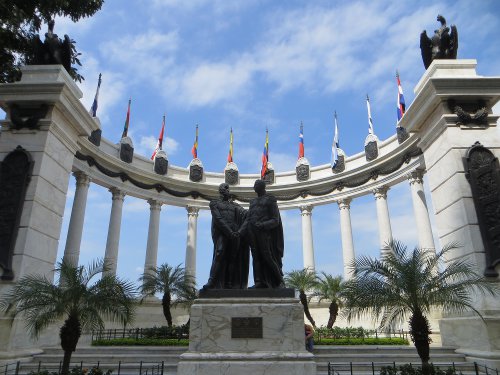
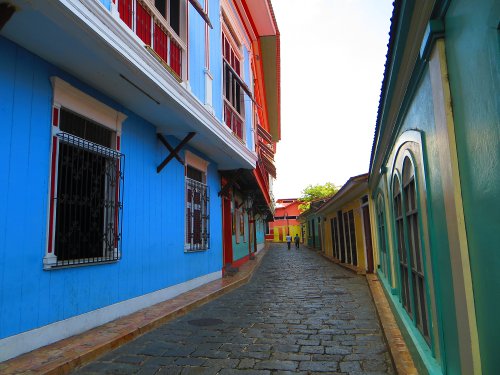
Fortin del Cerro and the Lighthouse: we walk up to this hilltop fort with a lighthouse that had spectacular views of the city and its surroundings.
Museo Nahim Isaias: this museum contained different art exhibitions on contemporary paintings, sport stamps created by kids, and a hall full of religious art.
Iglesia de San Francisco: this is the city’s most impressive church, which has been reconstructed and restored since the devastating 1896 fire.

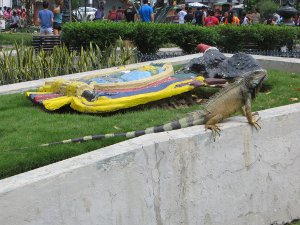
Bolivar Park: this plaza is better known as the Iguana Park due to the large amount of iguanas roaming around.
Guayaquil Cathedral: this cathedral is the successor of a previous wooden church that was destroyed in a fire in 1692. We went inside the reconstructed church that is designed in a neo-Gothic style and built between 1924 and 1937.
Museo Presley Norton: a small restored mansion houses an impressive collection of archaeological artifacts made by local indigenous groups.
Malecon del Salado: smaller than Malecon 2000, this waterfront promenade is dotted with eateries and cafes.
Museo Municipal: this museum contained many artifacts from the pre-Colombian indigenous groups of Valdivia, Machalilla, Chorrera, Guangala, and more. There was also a section depicting the city’s history from colonial times to independence.
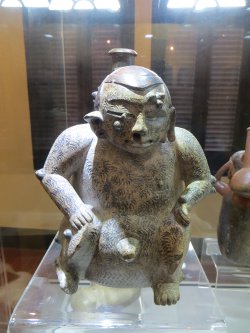
Galapagos Islands
Inspiration to Charles Darwin, who visited in 1835, we had the very fortunate opportunity to spend 10 days visiting three of the Galapagos Islands. Below are the activities we performed and the sights we visited on the islands, but to read more of our adventures, such as scuba diving with sharks, and see pictures and videos, be sure to visit our article.
Santa Cruz Island
Playa Estacion: on our way to the Charles Darwin Research Center we passed this beautiful white sand beach with large black lava rocks.
Charles Darwin Research Center: this conservation site protects giant tortoises and land iguanas. From different signage, we learned about the efforts to restore their populations on islands where they’ve been pushed to the brink of extinction.
Tortuga Bay: this beach is full of marine iguanas and with a cool water temperature it was perfect for a dip.
Lava Tunnels: we walked through an 800m (2600 ft) long dark lava tunnel that was formed when the outside skin of a molten-lava flow solidified.
Los Gemelos: we hiked around these twin craters that caved in under immense pressure. The giant sinkholes are surrounded by green vegetation.
Las Grietas: this crevice filled with salt water mixed in with some rain water, was great for a refreshing swim.
Scuba Diving: we made two immersions, the first in Beagle Rock and the second near Daphne Island. We saw many fish, marine turtles, hammerhead sharks, Galapagos reef sharks, small white tip sharks, sea lions, and marine turtles, it was amazing diving!!!
Isabela Island
Muro de las Lagrimas: we walked for about five hours, roundtrip, along this Wall of Tears trail. We passed different viewpoints, lagoons, and beaches to finally arrive to a 100m-long (328 ft) wall of lava rocks built by convicts under harsh and abusive conditions. The penal colony closed in 1959 but the wall stands as a monument to an infamous chapter in the island’s history.
Sierra Negra Volcano & Chico Volcano: we took a tour to these volcanos. We arrived at the first, Sierra Negra Volcano, at an altitude of 1124m (3688 ft). It is considered the oldest volcano on the island and is has the second largest caldera in the world. We continued hiking to Chico Volcano, a fissure of some parasitic cones, composed of slag and lava. We passed by some amazing colors and lava rock formations left by the last eruption.
Centro de Crianza de Tortugas: in this Giant Tortoise Breeding center we learned about the conservation efforts and the work being done to help restore the population on the island.
Villamil Lagoon: on our way to the breeding center we walk on a wooden boardwalk that passes over this lagoon with dense vegetation and mangroves. We saw many flamingos feeding and resting in the lagoon.
Los Tuneles: a series of lava flows created hundreds of arches and tunnels, both above and below the water. The striking geological formations are outdone only by the extraordinary collection of creatures that call this place home. We embarked on a tour boat to snorkel and walk amongst Mother Nature’s beauty.
San Cristobal Island
Interpretation Center: the center contains great exhibitions about the island’s natural history, human history, conservation, and development.
Cerro de las Tijeretas: we hiked up to the viewpoint on this Frigate-Bird Hill that provided good views of the island and, of course, many frigate birds.
La Loberia Beach: a rocky beach with a lazy sea lion colony, where we hung out for hours seeing the baby sea lions interact with each other.
Scuba Diving: we made two immersions: both were around the famous Kicker Rock/Leon Dormido. We first passed through the channel between the two rocks where we were completely surrounded by Galapagos reef sharks and white tip sharks. The highlight of our second dive was seeing a cloud of about 30 or 40 hammerhead sharks!! After the dives we visited Cerro Brujo Bay, a large moon-shaped bay with beautiful white sand beach.
Quito
Iglesia San Agustin: a historic 16th century church that was rebuilt in 1880 after damage from a significant earthquake.
Plaza Grande: this beautiful plaza located in the historic district was a great place to people-watch, view the lovely colonial buildings, and admire the surrounding hills, including El Panecillo.
Quito Cathedral: located in Plaza Grande, this cathedral was built between 1562 and 1565.


Centro Cultural Metropolitano: the main museum, Museo Alberto Mena Caamaño, in this cultural center was closed, but it hosted other temporary art exhibits.
La Compañia de Jesus: construction of this Jesuit church began in 1605 and was not completed for another 160 years. Quiteños call it the most beautiful church in the country.
Monasterio de San Francisco: we went inside the church of this monastery with its massive white towers and a backdrop of Volcan Pichincha. It’s the city’s largest colonial structure and its oldest church (built from 1534 to 1604).
Museo de la Ciudad: this museum housed in 1563 former hospital contained several exhibitions on the history of the city, including dioramas, model indigenous homes, and colonial kitchens.
Iglesia Santo Domingo: this 17th-century is designed with Moorish influence.
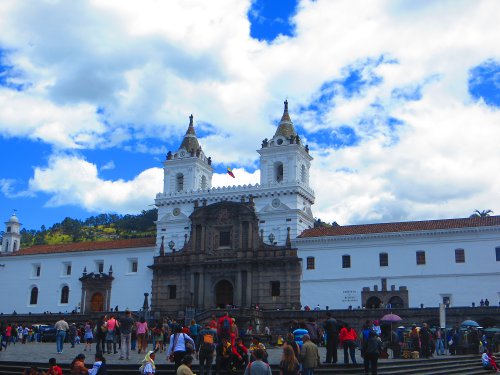
Calle La Ronda: this narrow lane is lined with restored, colorful colonial buildings that today are restaurants, cafes, shops, and galleries. We walked into one of these shops, Chez Tiff, an artisan chocolate store where we enjoyed some hot chocolate and learned about the history and process of making chocolate.
Mirador Guapulo: walking towards the district of Guapulo, we passed this lookout with amazing views of the valley.
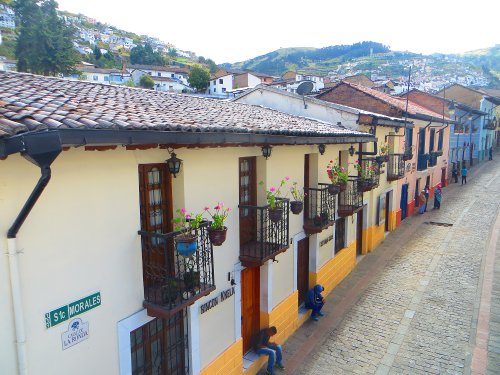
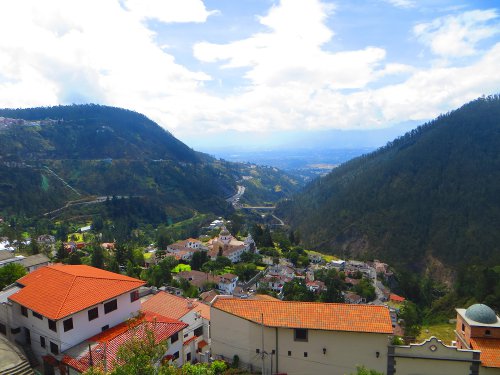
Iglesia Guapulo: this 17th-century church has a picturesque location and a Moorish influenced dome.
Museo Guayasamin and Capilla del Hombre: the former home of the famous indigenous painter, Oswaldo Guayasamin, this museum houses the largest collection of his work. We took a tour of his home learning about him and viewing his assortment of religious art, pre-Columbian ceramic, and metal sculptures. His remains were put inside a large ceramic pot and buried in the yard of the house, similar to local indigenous traditions. The Capilla del Hombre (Mankind’s Chapel) is the fruit of Guayasamín’s greatest vision, this giant monument/museum is a tribute to humankind, to the suffering of Latin America’s indigenous poor, and to the undying hope for a better world. The chapel is located in front of his house and contains many of his paintings.
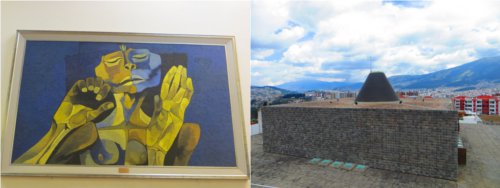
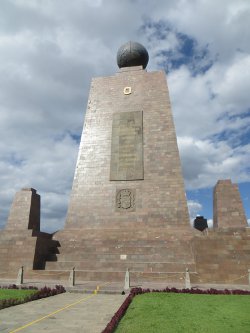
Parque La Carolina: we took a couple strolls in this park, enjoying some cevichocho and people watching.
Mitad del Mundo: just North of the city, this is the place where Charles-Marie de la Condamine made the measurements in 1736, proving that this was the equatorial line. The place, with a Mitad del Mundo (Middle of the World) monument, is a huge tourist trap that includes an entrance fee to see a couple lame museums and take a picture of the monument.
Museo Camilo Egas: this small museum contains a collection of works by one of the country’s foremost indigenous painters.
Basilica del Voto Nacional: built in 1926, this church is the largest neo-Gothic basilica in the Americas.
Museo Nacional: this museum exhibited a large collection of indigenous ceramics and gold, religious art, and national art such as paintings and photography.
Malchingui
Rhiannon Community: We spent two weeks volunteering in this semi self-sustained community. Although our departure was not ideal, we did learn a lot about bio-construction, organic farming, making compost, and cooking vegan/vegetarian dishes. Be sure to read about our experience in our article.
Otavalo
Cascada de Peguche: we hiked to this beautiful waterfall of 18 m (60 ft) in height, formed by the river of the same name.
Animal Market: we went to this market where indigenous men and women mill around with pigs, cows, goats, chickens, guinea pigs, and other animals trying to sell them.
Crafts Market: this market takes place every day at the Plaza de Ponchos, but on Saturdays, the official market day, the market swells into the surrounding streets. We went on a Saturday to see an astounding array of traditional crafts including tapestries, blankets, ponchos, sweaters, hammocks, carvings, beads, original paintings, and so much more.

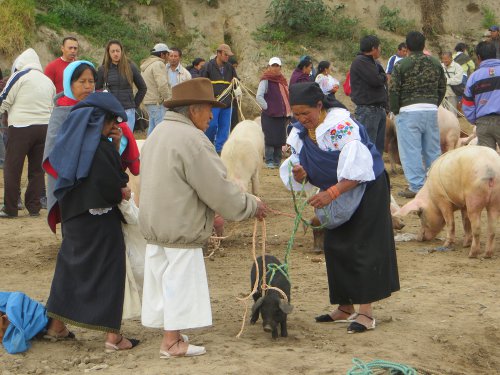
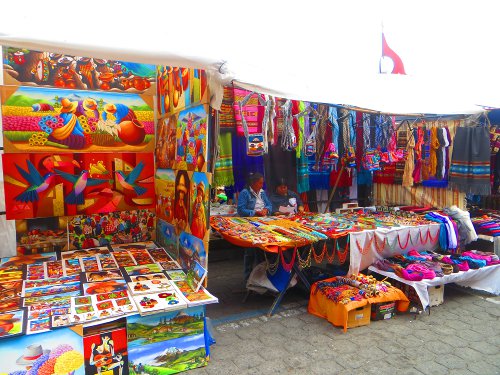
Cuenca
Parque Calderon: this park’s central feature is a monument to Abdon Calderon, a young cuencano who fought valiantly at the battle of Pichincha in 1822, a pivotal confrontation in Ecuador’s struggle for independence. Surrounding the park is the new cathedral with its huge blue domes and on the opposite side stands the diminutive old cathedral, known as El Sagrario.

Museo del Banco Central ‘Pumapungo’: the city’s most important museum has an entire floor of colorfully animated dioramas displaying traditional costumes of Ecuador’s diverse indigenous cultures, a coin exhibition, and local artist’s paintings. Out back is an archaeological park, where we walked through extensive ruins of buildings believed to be part of the old Incan city of Tomebamba.

Museo Manuel Agustin Landivar: this museum contains the All Saints Ruins (Ruinas de Todos Santos), which reveal Cañari, Inca, and Spanish ruins, layered one over the other.
Museo del Sombrero de Paja Toquilla: this small museum and hat seller reveals how panama hats have been made over the years.
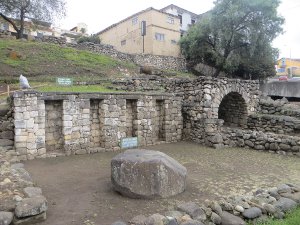
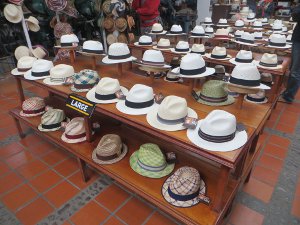
Sigsig and Chordeleg: we spent a day in these mountainous villages just outside the city. We walked around their markets and tried the local cuisine.
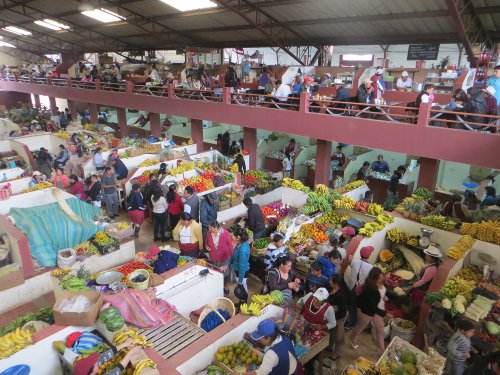
Loja
Puerta de la Ciudad: the city gates built in 1998/99 is said to be a replica of the city’s coat of arms and modeled after a medieval castle. It houses galleries which show contemporary Lojano artwork. Climbing the clock tower offers stunning views of the city.
Plaza San Sebastian: also called the Plaza of Independence, the most notable landmark of the city is located here: a 32 meter (105 ft) clock tower commemorating the declaration of independence from the Spanish Crown on November 18, 1820.

Vilcabamba
We spent a day in this scenic village with an ideal climate. Many tourists have moved and retired to this town because of the weather and laidback atmosphere. It is also known as the Valley of Longevity, because it is widely believed that its inhabitants grow to a very old age.

